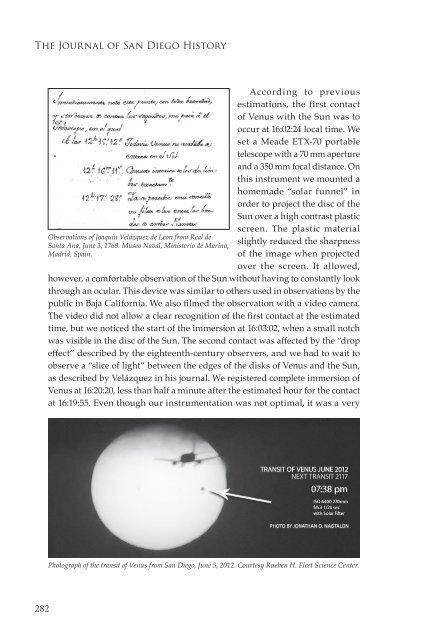Complete Issue Online - San Diego History Center
Complete Issue Online - San Diego History Center
Complete Issue Online - San Diego History Center
You also want an ePaper? Increase the reach of your titles
YUMPU automatically turns print PDFs into web optimized ePapers that Google loves.
The Journal of <strong>San</strong> <strong>Diego</strong> <strong>History</strong><br />
Observations of Joaquin Velázquez de Leon from Real de<br />
<strong>San</strong>ta Ana, June 3, 1769. Museo Naval, Ministerio de Marina,<br />
Madrid, Spain.<br />
According to previous<br />
estimations, the first contact<br />
of Venus with the Sun was to<br />
occur at 16:02:24 local time. We<br />
set a Meade ETX-70 portable<br />
telescope with a 70 mm aperture<br />
and a 350 mm focal distance. On<br />
this instrument we mounted a<br />
homemade “solar funnel” in<br />
order to project the disc of the<br />
Sun over a high contrast plastic<br />
screen. The plastic material<br />
slightly reduced the sharpness<br />
of the image when projected<br />
over the screen. It allowed,<br />
however, a comfortable observation of the Sun without having to constantly look<br />
through an ocular. This device was similar to others used in observations by the<br />
public in Baja California. We also filmed the observation with a video camera.<br />
The video did not allow a clear recognition of the first contact at the estimated<br />
time, but we noticed the start of the immersion at 16:03:02, when a small notch<br />
was visible in the disc of the Sun. The second contact was affected by the “drop<br />
effect” described by the eighteenth-century observers, and we had to wait to<br />
observe a “slice of light” between the edges of the disks of Venus and the Sun,<br />
as described by Velázquez in his journal. We registered complete immersion of<br />
Venus at 16:20:20, less than half a minute after the estimated hour for the contact<br />
at 16:19:55. Even though our instrumentation was not optimal, it was a very<br />
Photograph of the transit of Venus from <strong>San</strong> <strong>Diego</strong>, June 5, 2012. Courtesy Rueben H. Fleet Science <strong>Center</strong>.<br />
282







![[PDF] The Journal of San Diego History Vol 52: Nos 1 & 2](https://img.yumpu.com/25984149/1/172x260/pdf-the-journal-of-san-diego-history-vol-52-nos-1-2.jpg?quality=85)

![[PDF] The Journal of San Diego History - San Diego History Center](https://img.yumpu.com/25984131/1/172x260/pdf-the-journal-of-san-diego-history-san-diego-history-center.jpg?quality=85)







